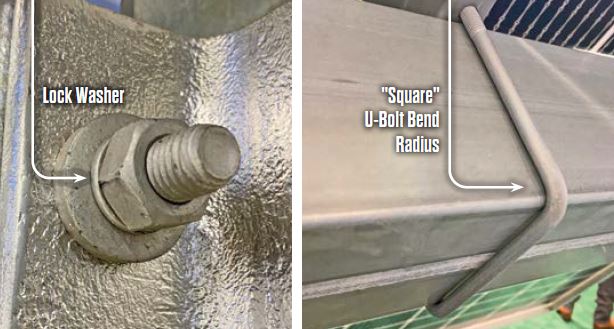
Mature industries are characterized by well-developed engineering practices, standards, quality management processes and highly reliable systems. The solar PV industry has generally not achieved this level of maturity in its structures and fastener technology.
During the 2022 RE+ event in Anaheim, Calif., this past September, a research team walked the Exhibit Hall and found many stark examples of industry immaturity. They reported the results in a feature exclusive to Solar Builder magazine.
The team performed an informal survey and spotted common misspecification and, in two cases, particularly extreme examples of misapplications. In one example, the team spotted car headliner fasteners, and with the second, a chain link fence component — both non-structural but called upon to maintain structural integrity.
The importance of fasteners within PV racking and tracker systems is often overlooked by system designers. Although composed of relatively simple and inexpensive components, fasteners play a critical role in the structural reliability of PV systems.
Joint engineering practices and standards in structural steel and transportation industries have matured over the past century and become widely adopted. As a result, failures of fastened joints (or bolted joints) in buildings and transportation are now rare. In comparison, the solar PV industry is relatively young and lacks the depth of engineering practices and standards of other industries. Loose, missing or broken bolts in solar are surprisingly common. When it happens, modules can become damaged, detached, or even worse, systems can collapse. All of these can increase maintenance costs, reduce system performance, or worst of all, create life-safety risks.
Industry audit underway
A project funded by the Department of Energy, Solar Energy Technology Office (DOE-SETO) is researching this very topic. The research team is made up of a mix of subject matter experts from academia and industry. Among other things, the team is working to find areas of transferable engineering knowledge from other industries.
The team recently conducted an audit of the solar PV racks and trackers on display at RE+ ’22. The team looked at 19 different racking products and examined 92 bolted joint designs. Of the 92 bolted joints examined, the team identified 83 areas of concern, many of which were quite serious and could potentially lead to significant financial loss and safety issues (for systems near pedestrians).
The researchers applied a traditional Failure Modes Effects Analysis (FMEA) framework to summarize the likely failure effects resulting from the bolted joints examined at RE. Most of the failure effects can be classified as “serious” in terms of potential financial and life-safety impacts. Here are two examples of fasteners found on the racks and trackers at RE+ ’22, which have been shown to either be ineffective or problematic in other industries.
For the full feature, exclusive to Solar Builder, access the digital edition right here. “Problematic” starts on page 50:
Solar Builder Instant Access
Get instant access to the digital edition of Solar Builder magazine.
Researchers: Jon Ness, president, Matrix Engineering Consultants; Gerald Robinson, principal investigator, LBNL; Tracy Becker, associate professor, UC Berkeley; James Elsworth, mechanical engineer, NREL; Holden Murphy, engineering student, Matrix Engineering
Industry stakeholders struggling with bolted joint challenges are invited to contact the research team; Gerald Robinson, principal investigator, Lawrence Berkeley National Laboratory, at gtrobinson@lbl.gov.
— Solar Builder magazine
Leave a Reply
You must be logged in to post a comment.